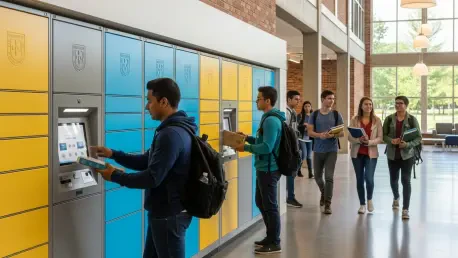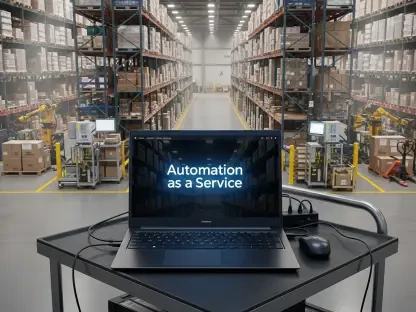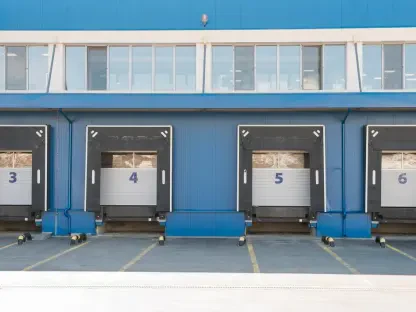Setting the Stage for a Logistics Revolution on Campus
In an era where e-commerce drives an unprecedented volume of parcel deliveries, university students in the UK often find themselves at the mercy of logistical inefficiencies, grappling with missed packages and insecure drop-off points in shared accommodations. This challenge has sparked a transformative response from Royal Mail and UPP, a leading provider of on-campus student housing, who have partnered to install parcel lockers at fourteen university residences. This initiative, kicking off at Nottingham Trent University, represents a pivotal shift in addressing student-specific delivery needs within a rapidly evolving market.
The purpose of this market analysis is to dissect the implications of this groundbreaking collaboration, exploring how it fits into broader trends of convenience-driven logistics and demographic-targeted solutions. With the parcel delivery sector experiencing exponential growth, understanding such niche innovations offers critical insights for stakeholders in education, housing, and logistics. This examination aims to uncover the potential of tailored services to reshape market dynamics, especially for high-density, transient populations like students.
By delving into current patterns, data on delivery demands, and projections for localized solutions, this analysis seeks to illuminate the strategic value of such partnerships. The focus extends beyond immediate benefits to students, considering how this model could influence competitive positioning and scalability across other sectors. Readers can anticipate a detailed breakdown of market drivers and future opportunities stemming from this innovative approach.
Unpacking Market Trends and Data in Parcel Delivery Solutions
Rising E-Commerce and Student-Centric Delivery Challenges
The UK parcel delivery market has seen a dramatic surge, fueled by e-commerce growth, with millions of packages shipped annually, a trend that shows no sign of slowing. University students, a demographic heavily reliant on online shopping for essentials ranging from academic materials to personal items, contribute significantly to this demand. However, their unique living situations in shared halls often result in logistical hurdles, including limited access to secure receiving points and unpredictable schedules that clash with standard delivery windows.
Data from industry reports indicate that missed deliveries cost both consumers and logistics providers in terms of time and resources, with students frequently cited as a group facing disproportionate inconvenience. Traditional solutions, such as off-campus collection points, often fall short due to distance and accessibility issues. This gap in service has created a ripe opportunity for targeted interventions, positioning initiatives like the Royal Mail-UPP partnership as a potential game-changer in addressing these pain points.
The collaboration’s focus on on-campus parcel lockers directly tackles these market inefficiencies by bringing convenience to the doorstep of student residences. As e-commerce penetration continues to deepen, with projections estimating sustained growth in parcel volumes through at least 2027, the demand for such hyper-local solutions is expected to intensify. This trend underscores the urgency for logistics players to adapt to specific consumer segments with innovative infrastructure.
Competitive Landscape and Royal Mail’s Strategic Positioning
Royal Mail, a dominant force in the UK logistics sector, operates within a competitive landscape where affordability and accessibility are key differentiators. With parcel services starting at just £1.55 online, the company maintains a cost advantage over many competitors who often charge higher rates for similar offerings. Coupled with an expansive network of nearly 24,000 drop-off and collection points—including 2,200 lockers and 11,500 Post Office branches—Royal Mail is well-positioned to cater to diverse customer needs, particularly in niche markets like university campuses.
The partnership with UPP enhances this positioning by integrating Royal Mail’s infrastructure directly into student environments, a move that competitors have yet to replicate at scale. While other delivery services may prioritize speed, they often lack the tailored approach seen in this initiative, such as label-printing capabilities via QR codes at lockers, which eliminate barriers like the need for personal printers. This strategic alignment with student housing providers could set a benchmark for market differentiation, potentially pressuring rivals to explore similar demographic-specific solutions.
Market analysis suggests that Royal Mail’s investment in such partnerships could yield long-term loyalty among younger consumers, a demographic critical to future revenue streams. However, challenges like maintenance costs and ensuring locker availability during peak periods, such as holiday seasons, pose risks to scalability. Balancing these factors will be essential for maintaining a competitive edge as the market for localized delivery solutions grows more crowded.
Projections for Hyper-Local Delivery Models
Looking ahead, the parcel locker initiative at UK universities reflects a broader market shift toward hyper-local delivery models designed for specific communities. Industry forecasts predict that by 2027, a significant portion of parcel services will pivot to such customized setups, driven by consumer demand for convenience and security. The success of the Royal Mail-UPP collaboration could catalyze similar deployments in other high-density settings, such as urban apartment complexes or corporate campuses, expanding the market scope for locker-based solutions.
Technological advancements, including AI-driven locker management to optimize space and app-based integrations for seamless user experiences, are expected to further propel this trend. Economic factors, such as rising delivery costs, may also encourage more partnerships between logistics firms and community-focused entities to share infrastructure expenses. Regulatory considerations, particularly around data privacy in digital tracking systems, will likely influence how these models evolve, requiring careful navigation by market players.
The student housing sector, in particular, stands as a testing ground for these innovations, with the potential to inform broader market strategies. If the current initiative proves scalable, it could redefine how logistics companies approach demographic segmentation, prioritizing accessibility and user-centric design. This projection highlights the need for continuous investment in technology and stakeholder collaboration to sustain growth in an increasingly fragmented delivery market.
Reflecting on Insights and Strategic Pathways Forward
Looking back, the market analysis of the Royal Mail and UPP partnership revealed a compelling response to the logistical challenges faced by university students, with parcel lockers at fourteen residences marking a significant step toward convenience and security. The initiative’s alignment with e-commerce growth trends and Royal Mail’s competitive strengths in affordability and network reach underscored its potential to reshape delivery dynamics for niche demographics. Projections of hyper-local models gaining traction further emphasized the transformative impact of such targeted solutions on the broader logistics landscape.
For logistics companies, the takeaway was clear: investing in demographic-specific infrastructure offered a pathway to differentiation in a crowded market, with opportunities to build consumer loyalty among younger generations. Universities and housing providers also saw value in adopting similar systems to boost resident satisfaction, suggesting pilot programs in high-traffic areas as a starting point. Meanwhile, technology providers were encouraged to develop supporting tools, like advanced locker management software, to address scalability challenges.
As a strategic next step, collaboration emerged as a cornerstone for success, with joint ventures between postal services, educational institutions, and tech innovators poised to drive the next wave of delivery solutions. Exploring integrations with campus apps or smart systems could further enhance user experiences, setting a new standard for convenience. This partnership served as a blueprint, urging market players to prioritize adaptability and consumer needs in shaping the future of parcel services.









